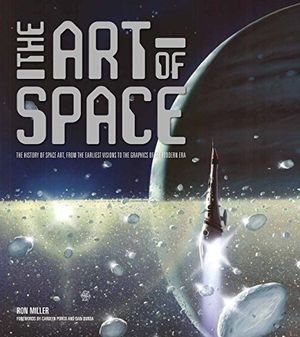Space Artists Go Where the Cameras Can’t
A new book shows the beauty, and the value, of space art.
/https://tf-cmsv2-smithsonianmag-media.s3.amazonaws.com/filer/34/14/34141b99-1abf-4ab0-832e-0e175a26d6b7/exploring_io_by_ron_miller.jpeg)
Space artist Ron Miller, an Air & Space contributing editor, is the author of The Art of Space: The History of Space Art, From the Earliest Visions to the Graphics of the Modern Era (Zenith Press, 2014). Miller spoke with Associate Editor Diane Tedeschi in August.
Air & Space: Why did you decide to write this book?
Miller: It was kind of a spinoff of wanting to do a new book about classic space artist Chesley Bonestell. In talking this over with the publisher, the book gradually evolved into an overview of space art generally—especially as it’s practiced by artists around the world today.
What artists were you influenced and inspired by?
In space art, Chesley Bonestell of course. I’d been fascinated by his art since I was in grade school. Which is probably something most other space artists would say. Later, other great space artists inspired me, such as Ludek Pesek.
What is your favorite genre of space art?
There are two basic kinds, known to us space artists facetiously as the “Rock and Ball” and “Swirly” schools. The former creates art like Bonestell’s: realistic landscapes with strange planets and moons in the sky. The latter approaches the art from more impressionistic or abstract directions. I’d say I’m firmly in the Rock and Ball camp.
Does space art stand on its own as great art?
I think so. After all, it has to succeed as art first, regardless of its subject matter. For instance, I think of my work as a kind of landscape painting, and a picture has to succeed as a good landscape before anything else. It cannot depend on the novelty of its subject to get by. Lester Cooke, who at one time was the curator of painting at the National Gallery, considered Bonestell to be one of America’s finest landscape painters because he recognized Bonestell’s space art as being great landscape painting first.

Do any space artists still use paint and ink on paper or canvas? Or is everything done digitally?
Not at all. I think the majority of space artists still work traditionally. There are just some things you cannot emulate with the computer. There are also artists who will mix traditional media and digital. There are even space artists working in wood and glass—even needlepoint.
Was space art more alluring when it was based on the artists’ imaginations?
That’s a question with a complicated answer. Space art in a way has never been based wholly on an artist’s imagination, at least when we are talking about representative art. It’s always been inspired by what science knows at the time, which may or may not have been very much. But even with the vast knowledge we now have of other worlds, space artists can still take viewers places satellites, probes, and landers have never been. For instance, I’ve recently taken some of the Pluto fly-by images and interpreted what I thought it would look like to stand on the surface of the planet and see the same features from the viewpoint of a future tourist. That requires a mixture of knowledge and imagination.
Has planetary imagery from unmanned space probes lessened the need for space art?
Nope. Very much for the reasons I gave in the last answer. There will always be places an artist can take a viewer that a probe has not visited. And there is a practical need for space art. All of the images taken by orbiters and fly-by probes are of necessity aerial views. They are looking down on their subjects from above. For many people, these images lack scale and context. The artist can show places from a more human viewpoint. This not only makes the planets and moons more real, but helps viewers understand what they see in the photos. In some ways, a space artist is like the artist who interprets what a dinosaur would look like in life from a collection of fossils.
Any advice for someone who would like to earn a living as a space artist?
I think a solid grounding in art is essential. You need to be a good artist before you can be a good space artist. And you should learn as much about astronomy as you can.
